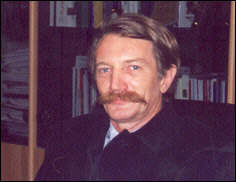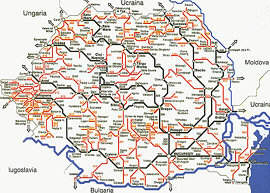
|

|

 National Passenger National Passenger
Railway Transport Company |
Eng. Valentin Bota,
General Manager
Contact:
CFR - Calatori S.A.
B-dul Dinicu Golescu, 38
77113, Sector 1, Bucharest - ROMANIA
Tel: 40 (1) 222.2518
Fax: 40 (1) 411.2054
E-mail: ivlad@central.cfr.ro
Web site: www.cfr.ro
|
 Strategy Strategy |
 INTRODUCTION AND OBJECTIVES INTRODUCTION AND OBJECTIVES |
The main objective of the restructuring and organization of the national Society of Passengers Railway Transportation "CFR Calatori" S.A. was to concentrate on the market evolution and to satisfy its own needs regarding circulation safety conditions and comfort according to the established standards.
The character of public transportation and social service obliges the company to insure a minimum of transport capacities with all railway relations and to maintain tariffs within the limits defined as acceptable considering the degree of comfort offered.
These essential particularities of the transport of passengers by railway are assured by the company. They are permanently correlated with market studies, with the analysis of the alternatives given by road and air transportation, and with strong measures for the optimal use of the resources and the assurance of an economic balance.

 EVOLUTION OF THE TRANSPORT MARKET EVOLUTION OF THE TRANSPORT MARKET |
Since the onset of CFR Passengers, several marketing services have been defined for the three identified main market segments:
Interregional traffic, covered by long distance trains, generally of superior class
Regional traffic, around important urban centers, generally characterized by a reduced distance and by the need of frequent stops
International traffic

These three departments permanently monitor the situation of the demand for transport and define the requirements of the train schedules.
The fulfillment of a circulation program closer to the public demands, the maintenance of the level of prices within tolerable limits, and an active policy of sales and control have refrained the decrease of traffic that occurred between 1990-1997. Since October 1998 the monthly number of passengers exceeded 11 million.
Ticketing and services to passengers
Nowadays, 19% of the passengers enjoy a tariff reduction of 50%. These passengers are mostly students, elderly citizens, etc. Almost 21% of the passengers use tickets paid by the companies they work for, and around 2,2% of the passengers (handicapped, Revolution or war veterans, etc) use free tickets paid by different organizations or ministries. This structure reflects the social service character of the public transport of passengers.
The past few years modifications in the structure of the labor force and the restructuring of many economic units, especially of the new industrial platforms, have led to a decrease of the number of people living in villages and working in the city. The weight of "frequent user cards" was reduced from of 15% in 1997 to 11,5% in 1999. Consequently the average distance traveled grew continuously to up to 9% in some months.

The main indicator that measures the company's activity is the passenger-km. This indicator helps to dimension both the number of trains and the economic activity. In 1999 this indicator met a relatively stable evolution: between 94 and 99%.
To be able to better satisfy the passengers requirements for the international train timetable during 1999/2000 a series of trains and direct wagons were introduced:
Train 388/389 "Carpati" between Bucharest and Warsaw
Train 460/461 "Transbalkan" in transit through Romania between Budapest-Bucharest-Thesalonika
Sleeping wagon CFR Bucharest-Paris
Sleeping wagon CFR Bucharest-Venice

Sleeping-wagons and the service in the wagon-restaurant require a detailed analysis of the market, as well as regulations and services adapted to this market in very well defined economical conditions. Since June 1999 this activity has been organized as a branch with juridical personality and its own management. Its strategy and presence in the market will be defined according to the resources that can generate this activity.
|
 TRANSPORT CAPACITY TRANSPORT CAPACITY |
Compared with the previous year, the decrease of the transport capacity expressed in train-km was of only 4-5%. There has been a reduction of short distance slow trains and better relations with fast and accelerate trains for the long distance passengers.

The offer for trains of higher comfort from the Intercity category has been substantially reduced to the required level, considering that this service does not have enough clients yet for the ratio quality/price that can be offered for the moment.
The number of special trains has increased almost 16 times through a better collaboration with the tourism agencies and a better knowledge of the market (even though their number is still very small).
The trains going on electrified lines (main lines) are almost 43% more than the trains with Diesel locomotives.
 ROLLING STOCK ROLLING STOCK |
To insure passengers the scheduled trains, the company took over at a number of locomotives and wagons with the strictly necessary dimensions.
Locomotives
Nowadays, the company has 817 locomotives divided as follows:
306 electric locomotives of 5100 kw
55 electric locomotives of 3400 kw
245 electric Diesel locomotives of 2100 HP
211 hydraulic Diesel locomotives of 1250 HP
The company also has 50 auto-engines, and in order to warm up the trains in wintertime it has 214 special wagons (WIT).
The average age of the locomotives is of more than 20 years, and for diesel locomotives of 28 years. However through reparations, revisions and maintenance, the necessary towing means for the passengers trains have been assured. The active percentage of locomotives is of 72%.
The towing of passenger trains with other locomotives (freight or SAAF) is done only in accidental cases and represents barely 1% of the towing activity.
Some important works for the modernization of the locomotives have been carried out. Here are some examples:
Hydraulic-diesel locomotives.
The modernization has been done together with Alsthom.
Electric-diesel locomotives.
The modernization process is still going on with General Motors.
Electric locomotives.
In Craiova based on a contract with Siemens.

Wagons
"CFR Calatori" S.A. has 4,491 wagons in its park (1/1/99) used in the composition of 1,800 trains. Their degree of availability is 85%.
Basically, the company's wagons can be divided into two large groups:
Relatively new wagons or reconstructed ones with a good technical situation. For these the maintenance and repairs will be improved and revisions will be made more frequently.
Wagons that can be reconstructed. These are between 15-20 years old. The technical state of these wagons is relatively good.
 INVESTMENTS AND MODERNIZATION INVESTMENTS AND MODERNIZATION |
In 1999 an investment plan was approved. It should be financed by the company's own funds at a value of 118,000 million lei. From this plan, 55,100 million lei have already been invested.
It is in the company's economic interest to reduce the period for the execution of the first phase of the modernization project and to pass, as soon as possible to the development of the second phase. This second phase will center on the connection to the data transmission network. Putting into practice the booking system is another priority. The total value of the second phase is estimated to be almost US$ 24 million, and it should be finished in 3 years.
 PROTECTION OF THE ENVIRONMENT PROTECTION OF THE ENVIRONMENT |
To properly develop the protection of the environment, the Regional Passenger Agencies have established a program in direct collaboration with the organizations responsible for these matters. The purpose is to improve the existing system for the collection of information and control.
The consumption of electric energy, fuel, lubricants and water has been monthly monitored according to national and international recommendations. In this way the evaluation of the impact on the environment can be assessed, an actual knowledge of the consumption will be obtained, and the consumption of fuel and natural resources can be reduced.
 PERSONNEL PERSONNEL |
CFR Calatori had around 24,240 employees on January
1st 1999. By December 31st
1999, the company managed to reduce this number
to 23,230 workers. To assure the necessary qualification
of the personnel and to adapt them better to the
new market conditions, the workers will follow courses
and will attend programs specific to the passengers
transport activity. |
|
© World INvestment NEws, 2000.
This is the electronic edition of the special country report on Romania published in Forbes Global.
July 24th 2000 Issue.
Developed by AgenciaE.Tv |
|
|
|
| |
|
|
|
|

